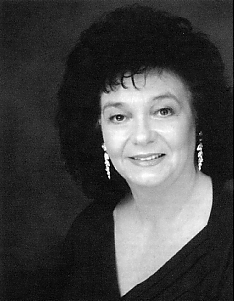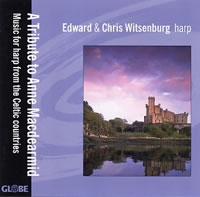| A Tribute to Anne Macdearmid Edward & Chris Witsenburg |
This recording presents a feast of Celtic harp music and a well-deserved tribute to Anne Macdearmid. Here fifteen of her duets — and a few carefully chosen solos for variety’s sake — have been brought together in one programme. The arrangements are played on two concert harps. Anne herself agreed wholeheartedly to this choice of instruments. In her own words: “play it on any type of harp: big, medium or small, as long as the melody sings”. Buy this album now CD: £12.00+ p&p
|
| Please click here for Artist Information, Contact Details and other recordings |
| 1 | An Droighnéan Donn (The Blackthorn Bush) | 2:08 |
| 2 | The Banks of the Suir | 2:31 |
| 3 | Mulhaire’s, Molly Bawn and The Green Mountain | 2:54 |
| 4 | Ar Lan y Môr (At the seashore) | 2:57 |
| 5 | Welsh Medley | 2:45 |
| 6 | * Mnathan a Ghlinne Sèo (Women of the Glen) | 2:25 |
| 7 | Chuir ad mise ann an sèomat fuar (I am in a cold cell) | 2:32 |
| 8 | * Och nan och (Sad am I) | 3:09 |
| 9 | Drunk at night and dry in the morning | 2:15 |
| 10 | An Gille Ban (The Fairhaired Lad) | 2:03 |
| 11 | ** Cailinn Fhuilt Ban (The Fairhaired Girl) | 2:00 |
| 12 | * Tir-Nan-Og (The Land of the ever young) | 4:46 |
| 13 | Helen of Kirconnell | 2:13 |
| 14 | Three Scots Jigs | 2:18 |
| 15 | Dream Angus | 2:41 |
| 16 | Red House | 2:24 |
| 17 | John McNeil | 1:18 |
| 18 | Spey in Spate | 1:14 |
| 19 | The Silver Moon my Mistress is | 2:46 |
| 20 | The Athole Highlanders | 2.12 |
| 21 | Oran nan Eilean (Music of the Islands) | 3.09 |
| 22 | Och nan och, tha mi fo mhulad (Och, I am sad) | 3.36 |
| 23 | Ceol Measgadh (Music Collection) | 3.02 |
| Total time | 59.51 |
|
| * Edward Witsenburg solo ** Chris Witsenburg solo | ||
 The
internationally acclaimed singer/harper Anne
Macdearmid has arranged
countless traditional melodies from Scotland, Ireland and Wales for
voice and harp, for clarsach solo (“clarsach” being the
Gaelic word for the small, diatonic blade harp) and for two Celtic
(or pedal) harps.
The
internationally acclaimed singer/harper Anne
Macdearmid has arranged
countless traditional melodies from Scotland, Ireland and Wales for
voice and harp, for clarsach solo (“clarsach” being the
Gaelic word for the small, diatonic blade harp) and for two Celtic
(or pedal) harps.
On this recording fifteen of her duets — and a few carefully chosen solos for variety’s sake — have been brought together in one programme. The arrangements are played on two concert harps. Anne herself agreed wholeheartedly to this choice of instruments. In her own words: “play it on any type of harp: big, medium or small, as long as the melody sings”. This recording presents a feast of Celtic harp music and a well-deserved tribute to Anne Macdearmid.
Anne Macdearmid was born and educated in Aberdeen, Scotland and first studied classical harp with Sanchia Pielou at the Royal Scottish Academy of Music and graduated in singing, harp and piano. Later she found that her true love was the clarsach (the small Celtic harp), both as a solo and accompanying instrument. Combining this with her singing, she has presented countless recitals and workshops all over the world.
She was Head of Music at Aberdeen Grammar School for 17 years and also conducted numerous courses, in particular the Heritage of Scotland Clarsach Summer School for 25 years in Edinburgh with students coming from Europe and the United States. Another of her talents being for composing and arranging, Anne has published 11 books which are in constant demand by players and teachers because of the musical and imaginative presentation.
Throughout history music has played a major role in the life of the Celts. They have been characterized, for example, as “music makers and dreamers of dreams”. The innate love of beauty is an essential element of the Celtic soul. Often both a sadness and a restlessness can be found in their songs, reflecting the mysterious, rhythmical, relentless pulse of the sea, especially in the melodies of the inhabitants of the islands (like the Hebrideans). The ever-present wind has also had an influence. Nature has clearly put a stamp on their music. These orally passed-on melodies are usually termed folk-music. The Scots, Irish and Welsh possess a wealth of poignantly beautiful traditional airs. Moreover for many centuries the harp has played an essential part in the music of the Celts, especially as the most appropriate instrument to accompany song. That tradition continues to this very day.
Melodies from Ireland:
An
Droighnean Donn (The Blackthorn Bush).
This tune appears in Edward Bunting’s “General Collection
of Ancient Irish Music” (1796). A love song in which the singer
says: “My love is like the blossom of the sloe that grows on the
blackthorn bush”.
The
Banks of the Suir.
The Suir is a river in the Republic of Ireland. It flows from Clonmel
through Carrick-on-Suir and on to Wesford.
Mulhaire's,
Molly Bawn and The Green Mountain.
Three lively traditional Irish reels (a quick, indigenous and probably
very ancient dance).
Songs from Wales:
Ar
Ian y Môr (At the seashore)
A simple, slow and wistful tune. Translated into English the first
stanza runs as follows: “At the seashore are red roses, At the seashore
are white lilies, At the seashore is my beloved, who sleeps at night
and rises in the morning”.
“Welsh
Medley”
The nest three relatively short melodies form a Welsh Medley:
Helar ysgyl’arnog (Hunting the Hare) conjures up a jolly hunt
on a fine day, of dogs chasing a hare, but not catching it.
Bugeilio'r Gwenith Gwyn (Watching the Wheat) is a melancholy love
song.
Pant conan yr wyn (The Lambsfold Vale) depicts the Welsh
countryside with gambolling lambs. Also known under the English
title: Strike the Harp.
Traditional music from Scotland:
Three melodies
form one larger solo work:
Mnathan a Ghlinne Sèo (Women of the Glen).
A traditional Highland melody. Alternatively known as “The Piper’s
Warning”, supposedly played by the Campbell piper just before the
impending massacre of the Glencoe MacDonalds (1692).
Chuir lad mise ann an sèomat fuar (I am in a cold cell).
Published by Marjorie Kennedy-Fraser in her extensive collection “Songs
of the Hebrides” (1909) under the title: Sleeps the noon in the
deep blue sky.
Och nan och (Sad am I).
An old historical lament written for the young Laird of Rassay, John
Garbh MacLeod who was drowned in the Minch about 1659.
Drunk
at night and dry in the morning.
A humorous title for a spirited 18 century violin melody.
An Gille Ban (The Fairhaired Lad).
The melody of a very old song of hopeless passion: she still loves him
tho’ she fears that he has deceived her.
Cailin’n
Fhuilt Ban (The Fairhaired Girl).
Another beautiful Gaelic air from the island of Lewis.
Tir-Nan-Og
(The Land of the ever young).
This is the Celtic Heaven, situated somewhere in the ocean, far away
to the west of the Hebrides. Also incorporated in this composition is
the ancient waulking (working) song “Heman Dubh”, sung by
the Hebridean women working at the tweed making. Anne Macdearmid wrote
the piece as a tribute to Edward Witsenburg on his 60th birthday.
Helen
of Kirconnell.
The small village of Kirconnell is in Dumfries and Galloway. The
sad tale of Helen who was killed by an arrow meant for her lover.
After taking his revenge he laments his lost love. The poem can be
found in Sir Walter Scott’s “Minstrelsy of the Scottish Borders” (1802-3).
Three
Scots Jigs.
A combination of three elegant dances from the late 18th century:
Mrs. John Clark’s Delight, Lady Elizabeth Cole’s Reel and Mrs.
Roy of Nenthorn’s Favourite.
Dream
Angus.
A well-known and loved Highland lullaby. A mother soothes her weeping
child: “Angus is here wi’dreams to sell, hush ye my baby
and sleep without fear, Dream Angus has brought you a dream, my dear”.
“Dancing
Strings” has been written for concert harp at the request of
Edward Witsenburg as a companion to the previous work "Tir-Nan-Og".
A setting of three Scottish reels:
Red House.
John McNeil.
Spey in Spate.
Melodies from Scotland:
The
Silver Moon my Mistress is.
An ancient song lamenting the death of a beloved girl and a longing to
be with her.
The
Athole Highlanders.
This march refers to the private army of the Duke of Athole in Perthshire,
the only person allowed to have this privilege in Britain and indeed
in Europe.
Oran
nan Eilean (Music of the Islands).
This piece is based on two Hebridean melodies: Long a Leumraich, an air
from Harris, with the middle section based on an air from Eriskay, H-Eadaraibh
a h-uinn O.
Och
nan och, tha mi fo mhulad (Och, I am sad).
A song of a Lewis exile, remembering his youth and his love for the island,
with the final hope that he may return and find peace and rest. The arrangement
has been specially written for two concert harps.
Ceol
Measgadh (Music Collection)
Based on Bu chaombh bhi mire, a Gaelic courting song, followed by a strathspey
(a Scottish dance characterized by its dotted rhythm), I dali u dali
and finally a quicker reel, Null thar nan eileanan.
CREDITS
Programme notes by Edward Witsenburg. With special thanks to Anne Macdearmid and Rachel Ann Morgan for their invaluable help and enthusiastic support.
Edward Witsenburg:
Wurlitzer Orchestral Grand, Cincinnati 1928
Chris Witsenburg: Lyon & Healy, Style 23, Chicago 2001
Producer: Martijn van Campen
Recorded: Nederlands Hervormde Kerk, Markenbinnen, November 2005
Cover Illustration: Dunvegan Castle, Isle of Skye, Scotland
Cover & booklet design: Artwize, Charlotte Boersma
© 2006
Klaas Posthuma Productions
Made in The Netherlands
GLOBE™ is a registered trademark of Klaas Posthuma Productions,
Castricum, The Netherlands
| Title: | A Tribute to Anne Macdearmid |
| Artist: | Edward & Chris Witsenburg |
| Instruments: | Harp |
| Genre: | Trad / Contemporary |
| Format: | Audio CD |
| Our Ref: | A0098 |
| MCPS: | GLO 5217 |
| Label: | Globe |
| Year: | 2006 |
| Origin: | Netherlands |
